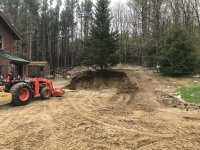s219
Super Member
- Joined
- Dec 7, 2011
- Messages
- 8,548
- Location
- Virginia USA
- Tractor
- Kubota L3200, Deere X380, Kubota RTV-X
Need to know what you plan to do.
My short answer is that both are required for some tasks such as grading and driveway maintenance. In other cases, only one may be necessary.
The FEL's primary purpose is to help you distribute loose material from a stockpile. The box blade's primary purpose is to grade material already on the ground, whether new or old material. The purpose/design of the box blade is to be able to move material and it has the ability to redistribute material from high spots to low spots. There are subtle differences in the FEL versus box blade and in the type of material operation. That will dictate which is the tool of choice.
When regrading land as I did last week, both were required. When improving a driveway, as I will be doing next week, both are required. For periodic driveway maintenance where no new material is involved, I can do it all with just the box blade (or land plane i many cases).
I know some folks who swear that backdragging with the front bucket is all they need, but I have tried that and it's not even close to the sophistication I can get with a box blade. It's good to get you within 70% of your target in many cases, but that's about it.
As shown in the movie and graphics up above, angle of attack is key to box blade use. Having a hydraulic top link (or an easily accessible/adjustable turnbuckle top link) will give you very precise control over how the box performs. I have a hydraulic top link and I am adjusting it hundreds of times a day when doing grading work. I can fine tune what I want the box to do and I can fine tune the behavior for forward operation or reverse operation, on the fly. It significantly improves the productivity of the box blade.
My short answer is that both are required for some tasks such as grading and driveway maintenance. In other cases, only one may be necessary.
The FEL's primary purpose is to help you distribute loose material from a stockpile. The box blade's primary purpose is to grade material already on the ground, whether new or old material. The purpose/design of the box blade is to be able to move material and it has the ability to redistribute material from high spots to low spots. There are subtle differences in the FEL versus box blade and in the type of material operation. That will dictate which is the tool of choice.
When regrading land as I did last week, both were required. When improving a driveway, as I will be doing next week, both are required. For periodic driveway maintenance where no new material is involved, I can do it all with just the box blade (or land plane i many cases).
I know some folks who swear that backdragging with the front bucket is all they need, but I have tried that and it's not even close to the sophistication I can get with a box blade. It's good to get you within 70% of your target in many cases, but that's about it.
As shown in the movie and graphics up above, angle of attack is key to box blade use. Having a hydraulic top link (or an easily accessible/adjustable turnbuckle top link) will give you very precise control over how the box performs. I have a hydraulic top link and I am adjusting it hundreds of times a day when doing grading work. I can fine tune what I want the box to do and I can fine tune the behavior for forward operation or reverse operation, on the fly. It significantly improves the productivity of the box blade.
